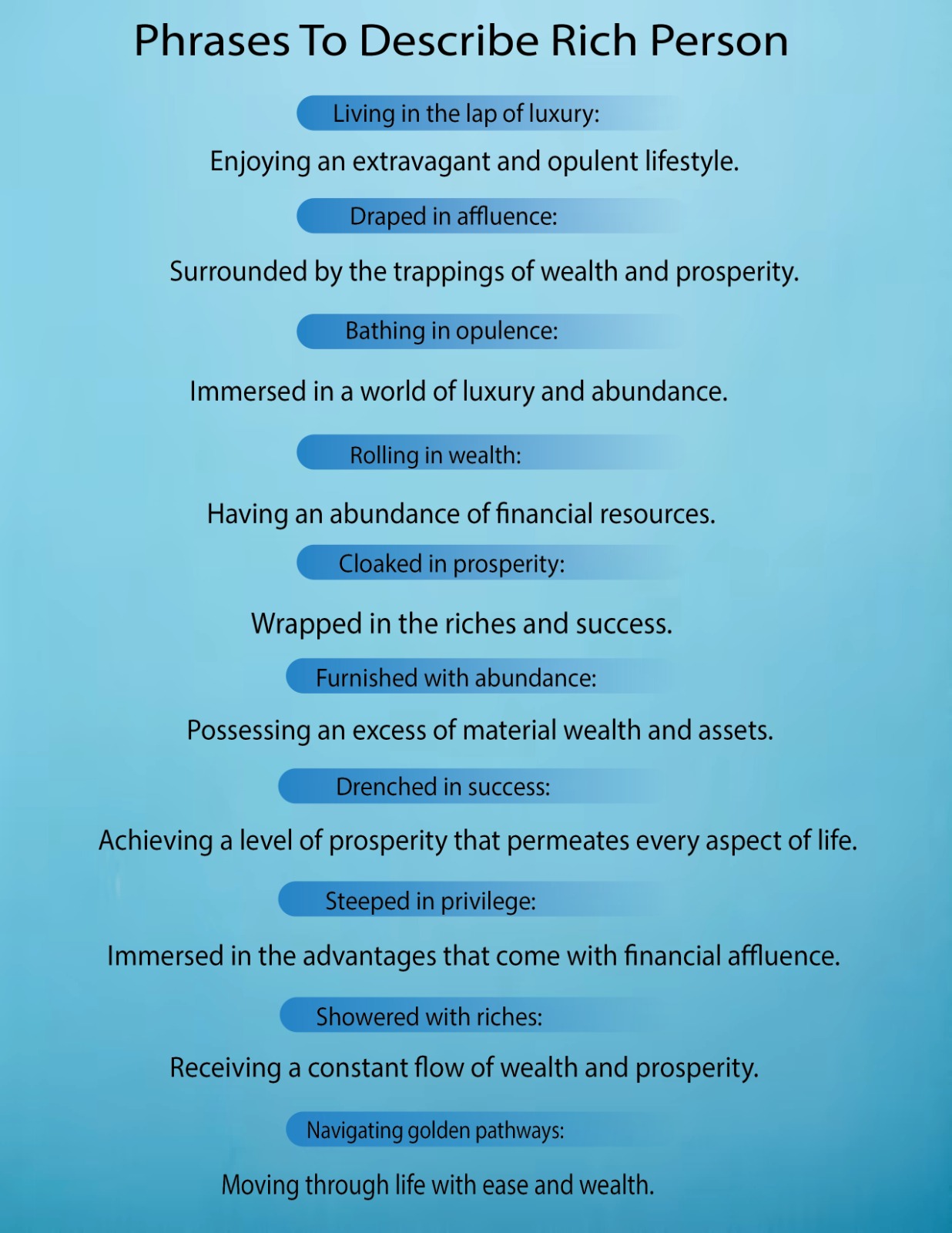How To Describe A Rich Person In Writing (10 Best Tips, Words &Phrases)
How To Describe A Rich Person In Writing
How To Describe A Rich Person In Writing: Describing a rich person in writing is akin to capturing the essence of opulence and privilege with the stroke of a pen.
It’s a literary endeavor that goes beyond the superficial trappings of wealth, delving into the complexities of character, environment, and aspiration.
To effectively portray a rich person, one must craft a narrative that immerses the reader in a world of affluence, evoking not just the material extravagance but also the intricate tapestry of emotions, motivations, and symbolism that define such characters.
In this exploration, we will delve into the art of painting a rich person’s portrait through descriptive language, sensory details, and narrative techniques, ensuring that their opulent world comes alive on the page, leaving an indelible mark on the reader’s imagination.
How To Describe A Rich Person In Writing
Here’s a step-by-step process on How To Describe A Rich Person In Writing:
Research and Gather Background Information
Begin by researching the character’s wealth sources, such as inheritance, business, or investments. Understand their financial history and personality traits.
Develop a Clear Character Profile
Create a detailed profile that includes their physical appearance, personality traits, and background. This will serve as the foundation for your description.
Choose the Right Adjectives
Select adjectives that reflect their wealth and personality, such as “affluent,” “extravagant,” or “influential.” These adjectives will help paint a vivid picture.
Incorporate Sensory Details
Use sensory descriptions to engage the reader’s senses. Describe the character’s attire, surroundings, and possessions in detail.
Set the Scene
Select appropriate settings that reflect the character’s opulent lifestyle, whether it’s a mansion, penthouse, or exclusive event.
Depict Interactions and Behavior
Showcase the character’s dialogue, communication style, and social interactions. Highlight their confidence and authority.
Explore Character Development
Delve into their inner thoughts, motivations, and any flaws or complexities that add depth to their personality.
Utilize Symbolism and Metaphor
Employ symbols and metaphors to represent their wealth and status, creating layers of meaning within the narrative.
Choose the Narrative Perspective
Decide on the narrative perspective that best suits your story, whether it’s first-person, third-person limited, or omniscient.
Craft a Compelling Description:
Weave together all the elements above to create a rich and captivating portrayal of the rich person in your writing.

Words To Describe Rich Person In Writing
Affluent: Possessing considerable wealth and financial resources.
Opulent: Displaying great wealth, luxury, and abundance.
Prosperous: Enjoying success and financial well-being.
Wealthy: Having a substantial amount of money, assets, and resources.
Affluential: Combining affluence and influence, suggesting both wealth and power.
Well-to-do: Enjoying a comfortable and prosperous lifestyle.
Loaded: Informal term conveying significant wealth or abundance.
Prospering: Experiencing growth and success in terms of wealth.
Moneyed: Having ample financial means and resources.
Well-heeled: Possessing abundant financial resources, often used in a refined context.
Fortunate: Enjoying financial success and good fortune.
Well-off: Living in a state of financial comfort and security.
Privileged: Having special advantages, often including financial ones.
Affluence: The state of having a great deal of wealth and prosperity.
Well-financed: Adequately funded or supported financially.
Wealth accumulator: A person who actively gathers and increases their wealth.
Financially secure: Having a stable and secure financial position.
Loaded with assets: Possessing a significant amount of valuable possessions and investments.
Money-minded: Oriented toward financial success and accumulation.
Keep in mind that the tone and nuance can vary based on the context and the specific traits you want to emphasize.
Phrases To Describe Rich Person
Living in the lap of luxury: Enjoying an extravagant and opulent lifestyle.
Draped in affluence: Surrounded by the trappings of wealth and prosperity.
Bathing in opulence: Immersed in a world of luxury and abundance.
Rolling in wealth: Having an abundance of financial resources.
Cloaked in prosperity: Wrapped in the riches and success.
Furnished with abundance: Possessing an excess of material wealth and assets.
Drenched in success: Achieving a level of prosperity that permeates every aspect of life.
Steeped in privilege: Immersed in the advantages that come with financial affluence.
Showered with riches: Receiving a constant flow of wealth and prosperity.
Navigating golden pathways: Moving through life with ease and wealth.

Understanding the Character
Understanding the character is like peeling back the layers of a treasure chest, each layer revealing another facet of their opulent existence.
It’s about delving beyond the glittering facade of wealth, navigating through the labyrinth of their ambitions, and deciphering the complex dance between extravagance and vulnerability.
In this realm of riches, the character is a living paradox, a blend of grandiosity and humanity, a connoisseur of luxury yet a prisoner to their own desires.
To truly understand them is to unlock the secrets of their opulent world, where every emotion is gilded, every desire has a price, and every choice echoes through the hallowed halls of their affluent soul.
Research and gather background information
Researching and gathering background information is the first step in crafting a compelling portrayal of a wealthy character.
It’s akin to detective work, where you unearth the origins of their prosperity and the tapestry of their life. You delve into the annals of their family history, scrutinize their business empires, and uncover the financial milestones that led them to opulence.
This meticulous research allows you to paint a vivid canvas of their wealth journey, tracing the roots of their affluence and providing insight into their motivations, be it a relentless pursuit of success or the weight of inherited riches.
Through this process, you excavate the character’s past, revealing the foundation upon which their opulent present stands, creating a rich tapestry of context for your narrative.
Wealth sources (inheritance, business, investments)
Wealth sources are the bedrock upon which the opulence of our character rests, each a unique facet of their financial narrative.
Inheritance, the most storied of origins, endows them with riches passed down through generations, a legacy of prosperity steeped in history.
Business, another avenue to affluence, casts them as enterprising visionaries, navigating the tumultuous seas of commerce with acumen and tenacity, accumulating fortunes through ingenious ventures.
Investments, the subtle art of growing wealth, makes them astute financiers, multiplying their riches through shrewd choices in stocks, real estate, and diverse portfolios.
These sources, like threads woven into the fabric of their life, shape the character’s identity and illuminate the diverse pathways to their sumptuous existence.

Personality traits (ambitious, extravagant, philanthropic)
The character’s personality traits are the kaleidoscope of qualities that add depth and dimension to their opulent persona.
Ambitious to the core, they exude an insatiable hunger for success, relentlessly pursuing their goals with unwavering determination, a characteristic that propels them ever higher on the ladder of affluence.
Extravagance is their second nature, as they revel in the finer things in life, from lavish parties to couture wardrobes, casting a gilded glow on their existence.
Yet, beneath the veneer of opulence, lies a philanthropic heart, as they use their wealth and influence to effect positive change, donating to noble causes and championing charitable endeavors.
This blend of ambition, extravagance, and philanthropy creates a character as complex as the layers of their luxurious lifestyle, making them a captivating subject of literary exploration.
Develop a clear character profile
Developing a clear character profile is akin to sculpting a masterpiece, chiseling away the excess to reveal the essence of our rich character.
It involves meticulously crafting their backstory, motivations, and quirks, layer by layer, until they come alive on the page.
From the details of their upbringing in opulence to the defining moments that molded their ambitions, a well-defined character profile breathes life into their opulent existence.
It’s not just about their physical attributes or financial status, but also their emotional landscape, desires, and inner conflicts.
A rich character profile becomes the blueprint, guiding the narrative and allowing the reader to navigate the intricacies of their opulent world with empathy and fascination, making the character an indelible presence in the reader’s imagination.
Descriptive Language
Descriptive language is the artist’s palette, the alchemy of words that transforms mere sentences into vivid, living tapestries of imagination.
It’s the symphony of adjectives that unveils the character’s opulence with each stroke of the pen, casting a spell of grandeur and allure over the reader.
It’s about choosing words that shimmer like rare gems, evoking the decadence of a diamond-studded bracelet or the silken touch of a couture gown.
Through this linguistic sorcery, the opulent world of our character unfolds, immersing the reader in a sensory banquet of sights, sounds, scents, and sensations.
Descriptive language isn’t just a tool; it’s the magic wand that transports readers into the opulent realm, where they can taste the extravagance, hear the echelons of affluence, and bask in the radiance of wealth’s language.
Choosing the right adjectives
Choosing the right adjectives is akin to selecting the finest jewels for a royal crown. It’s about meticulously curating a lexicon that elevates the narrative and paints a vivid portrait of opulence.
Adjectives like “opulent,” “sumptuous,” and “lavish” drape the character’s world in a regal richness, while “arrogant,” “magnanimous,” or “influential” capture the nuances of their personality.
These carefully chosen adjectives are the brushstrokes that add depth and texture to the canvas of the character, allowing readers to feel the weight of their wealth, the allure of their charisma, and the complexities of their opulent existence.
Like a skilled jeweler, the writer must ensure that each adjective sparkles with just the right brilliance, creating a literary masterpiece that dazzles the imagination.
Personality-related (arrogant, generous, influential)
Personality-related traits are the jewels adorning the character’s opulent crown of identity.
Arrogance, like a polished gem, lends them an air of unwavering self-assuredness, an unapologetic confidence born from the opulence they’ve amassed.
Generosity, akin to a precious pearl, shines through as they bestow their wealth upon worthy causes, elevating their character beyond the confines of their riches.
Influence, a coveted currency in their opulent world, casts them as power-brokers, their mere presence commanding attention and shaping destinies.
These personality traits are the facets of their character, reflecting the multifaceted nature of their existence, and adding intrigue to their opulent persona, making them a captivating subject of literary exploration.
Incorporating sensory details
Incorporating sensory details is like weaving a tapestry of opulence that readers can touch, taste, and feel. It’s the art of evoking the sensory delights of opulent living through words.
Visual descriptions bring to life the sparkle of diamonds, the opulence of silk, and the gleam of polished marble.
Auditory details let readers hear the whisper of expensive fabrics, the clinking of champagne glasses, and the hushed tones of privileged conversations.
Olfactory descriptions carry the scent of exquisite perfumes, the aroma of gourmet cuisine, and the fragrance of rare blossoms.
Tactile details allow readers to experience the smoothness of cashmere, the cool touch of fine china, and the warmth of a roaring fireplace.
By appealing to the senses, the opulent world of the character becomes tangible, enveloping readers in a sensory symphony that makes the narrative unforgettable.

Visual descriptions (expensive attire, luxurious accessories)
Visual descriptions transport readers into the opulent world of the character, where every detail is a brushstroke on a canvas of luxury.
Expensive attire drapes the character in fabrics that whisper opulence, from the sheen of silk evening gowns to the tailored perfection of bespoke suits.
Every stitch and fold conveys wealth’s elegance. Luxurious accessories are the finishing touches that add a glint of extravagance, whether it’s the sparkle of a diamond necklace, the gleam of a designer watch, or the shimmer of custom-made shoes.
These visual elements paint a portrait of refinement, allowing readers to visualize the character’s opulent appearance with every meticulous detail, making their world come alive in the reader’s mind like a masterpiece in a gilded frame.
Auditory descriptions (authoritative voice, exclusive events)
Auditory descriptions in the opulent world of our character resonate with an air of authority and exclusivity. Their voice carries the weight of confidence and influence, a tone that commands attention in any room.
It’s the melodic cadence of their speech, as they discuss matters of great consequence or deliver speeches at exclusive gatherings, leaving a lasting impression.
Exclusive events attended by the character are symphonies of privilege, where the sound of clinking crystal glasses, the hushed conversations of influential guests, and the strains of live orchestras create a harmonious ambiance of opulence.
Through auditory descriptions, readers can almost hear the opulent world, its elegance and exclusivity echoing in every note and word, immersing them in a realm of affluence and sophistication.
Olfactory descriptions (scent of expensive perfume, leather)
Olfactory descriptions in the opulent tapestry of our character’s world are like fragrant notes that linger in the reader’s imagination.
The scent of expensive perfume, a subtle symphony of rare flowers and exotic spices, envelops the character, leaving a trail of sophistication and allure in their wake.
The aroma of finely crafted leather, whether from a luxury car’s interior or a plush designer accessory, carries with it the unmistakable essence of opulence, evoking the tactile pleasure of supple surfaces and meticulous craftsmanship.
These olfactory details are like invisible threads, weaving through the narrative, allowing readers to smell the richness of the character’s environment, and enhancing the sensory experience, making their opulent world all the more immersive and captivating.
Tactile descriptions (smooth silk, firm handshake)
Tactile descriptions invite readers to experience the opulent world of our character through touch. The smoothness of silk caresses the skin like a gentle breeze, enveloping them in luxurious comfort.
It’s the sensation of sumptuous fabrics draping their form, imbuing every gesture with elegance. A firm handshake, on the other hand, is a tactile assertion of power and confidence, a gesture that leaves an indelible mark, much like the character’s presence in any room.
These tactile details create an intimate connection between readers and the opulent setting, allowing them to feel the opulence, elegance, and authority that define the character’s world, making the narrative come alive with sensory richness.

Setting the Scene
Setting the scene is like arranging the stage for a grand opera, where opulence takes center stage and each detail is a note in the symphony of extravagance.
It’s about crafting the backdrop against which our characters shine, whether it’s a luxurious mansion with gilded accents, a high-end penthouse in the heart of the city, or the sprawling deck of a private yacht.
The opulent world unfolds in these settings, where lavish décor and elegant furnishings become characters themselves, telling a story of wealth and refinement.
With every scene set, readers step into a realm where every detail whispers opulence, and the ambiance is a tapestry of luxury that envelops them, leaving an indelible mark on their literary senses.
Selecting the appropriate setting
Selecting the appropriate setting is like choosing the perfect frame for a masterpiece. It’s a critical decision that sets the stage for the character’s opulent world to unfurl.
Whether it’s a opulent mansion with marble pillars and crystal chandeliers, a high-end penthouse overlooking a dazzling cityscape, or the serene deck of a private yacht navigating azure waters, the setting becomes a character in its own right.
It not only reflects the character’s affluence but also complements their personality and the narrative’s tone.
The right setting provides the backdrop against which the character’s opulence and complexities can truly shine, making it an integral part of the storytelling process, adding depth, and elevating the narrative to new heights of richness and immersion.
Conveying the ambiance
Conveying the ambiance in the opulent world of our character is akin to capturing the essence of a fleeting moment in a grand symphony.
It’s about describing the atmosphere that envelops every scene, from the hushed elegance of a gala to the intimate opulence of a private chamber.
Lavish décor and elegant furnishings set the tone, creating an ambiance that exudes luxury and refinement. The play of soft lighting, the hum of sophisticated conversations, and the discreet service of staff add layers of sophistication to the setting.
Whether it’s a sense of regal grandeur or an intimate cocoon of extravagance, the ambiance is the emotional backdrop that allows readers to immerse themselves fully in the opulent world, making every scene a sensory journey through the character’s affluence and the story’s atmosphere.
Interactions and Behavior
Interactions and behavior within the realm of opulence are like the choreography of an exclusive ballet, where every gesture and conversation is a carefully orchestrated performance.
In this world, the character’s dialogue is imbued with the refined language of influence, a symphony of eloquence that resonates with authority and charm.
Their social interactions are a dance of power and privilege, where connections and alliances are forged over crystal glasses and within hallowed halls.
Gestures and body language, from confident postures to extravagant gestures, are the nuances that reveal the character’s opulent identity, expressing their charisma, assertiveness, or vulnerability.
In this intricate dance of opulence, every interaction and behavior is a revelation, a window into the character’s soul, and a testament to the captivating allure of their affluent world.
Dialogue and communication style
Dialogue and communication style in the opulent world of our character are like finely tuned instruments in an orchestra, each note resonating with authority, charm, and eloquence.
Their words are polished gems, carrying the weight of influence and sophistication. Every sentence is a carefully crafted symphony of language, rich with vocabulary that reflects their opulent lifestyle and education.
Their conversational style is a blend of authority and graciousness, conveying confidence without arrogance, and charm without affectation.
Whether negotiating high-stakes deals or engaging in social banter at exclusive gatherings, their dialogue is a testament to their power, influence, and the nuances of their personality.
It’s through their words and communication style that readers are drawn into the opulent world, where language is a currency of elegance and a key to unlocking the character’s opulent identity.
Social interactions
Social interactions in the opulent world of our character are like a finely choreographed ballet, where each move is calculated, every exchange a delicate negotiation.
Within this exclusive sphere, relationships are currency, and every encounter is an opportunity to forge alliances or assert dominance.
The character navigates a landscape of power plays and social hierarchy with grace, balancing the art of networking with the preservation of their opulent image.
Whether at extravagant galas, elite clubs, or intimate soirees, their interactions are a high-stakes performance, where charisma and influence are on full display.
These social dynamics reveal the character’s mastery of this opulent arena, showcasing their ability to navigate the complex web of social connections that defines their world.

Character Development
Character development in the opulent realm is akin to sculpting a masterpiece from the rarest of marble. It’s about peeling away the layers of extravagance to reveal the complexities beneath.
In this world of excess, the character’s inner thoughts and motivations are the jewels hidden in the vault of their soul.
Ambitions soar like eagles, driven by the relentless pursuit of success, yet beneath the facade of opulence, vulnerabilities lie like fragile porcelain.
It’s a dance between the alluring allure of wealth and the profound yearning for significance, where every emotion is heightened, every desire magnified.
Character development here is a voyage through the labyrinth of their affluence, uncovering the intricate tapestry of their identity, one thread of opulence at a time, until the reader is left with a multifaceted, enigmatic figure that lingers in their literary memory.
Inner thoughts and motivations
Inner thoughts and motivations in the opulent world are like the hidden gems of a treasure chest, waiting to be unearthed.
Within the glittering facade of wealth and extravagance, the character’s mind is a labyrinth of desires, ambitions, and secrets.
Their inner thoughts reveal the driving forces behind their opulent pursuits, whether it’s an insatiable hunger for success, a quest for validation, or a yearning for meaning beyond material riches.
These thoughts are the whispers of vulnerability in a world of opulence, a glimpse into the emotional complexities that lie beneath the surface.
Understanding their motivations adds depth to the character, unraveling the enigma of their opulent existence and making them a compelling figure in the narrative, where opulence meets introspection.
Character flaws and complexities
Character flaws and complexities in the opulent world are the facets of the character’s personality that add depth and intrigue to their opulent persona.
Beyond the dazzling exterior, there may be flaws like arrogance, materialism, or a sense of entitlement that humanize the character and reveal their imperfections.
These complexities might manifest as inner conflicts, dilemmas of conscience, or a yearning for genuine connection amidst the sea of superficiality.
The opulent world is a realm of extremes, and these flaws and complexities serve to contrast the character’s affluence with their humanity, making them relatable and multi-dimensional.
They are the cracks in the gilded veneer, where vulnerability and authenticity reside, inviting readers to explore the character’s journey of self-discovery amid opulence’s seductive allure.
Symbolism and Metaphor
Symbolism and metaphor in the opulent narrative are like hidden codes, waiting to be deciphered by the reader.
They transform ordinary objects into profound emblems of extravagance and power, such as golden gates symbolizing entry into a world of privilege or diamond-studded moments representing the character’s life of luxury.
These literary devices are the secret passages into the character’s psyche, revealing their innermost desires and fears through the glittering metaphors and hidden symbols that adorn their opulent existence.
They enrich the narrative, adding layers of meaning and complexity, inviting readers to explore the opulent world not just on its surface but within its depths, where every symbol and metaphor is a breadcrumb leading to the heart of the character’s opulent story.
Use of symbols to represent wealth
The use of symbols to represent wealth is the art of transforming ordinary objects into glittering icons of opulence.
It’s the golden gates that guard the entrance to the character’s world, signifying a threshold to privilege and luxury.
It’s the diamond-studded watches that adorn wrists, marking time not just in hours but in the currency of affluence.
These symbols are the language of opulence, speaking in the subtle eloquence of wealth. They are the coded messages within the narrative, conveying the character’s status, aspirations, and identity in a world where symbols aren’t just accessories but proclamations of power and prestige.
Through these symbols, readers decode the character’s opulent story, uncovering the meaning behind the glitter and the essence beneath the extravagance.

Symbolic objects or motifs
Symbolic objects or motifs in the opulent narrative are like recurring themes in a grand symphony, adding depth and resonance to the character’s story.
They are more than just physical items; they carry layers of meaning and narrative weight.
Whether it’s the luxury cars that symbolize status and ambition, the private jets that represent mobility and freedom, or the designer labels that cloak the character in opulence, these motifs become touchstones in the narrative.
They serve as metaphors for the character’s desires, values, and aspirations, weaving a rich tapestry of symbolism that enriches the storytelling.
Like a leitmotif in music, these symbolic objects and motifs recur, emphasizing the character’s opulent identity and inviting readers to delve deeper into the intricate composition of their affluent world.
Narrative Perspective
Narrative perspective in the opulent tale is like a prism that refracts the opulence through different facets. It’s a kaleidoscope of viewpoints, each offering a unique vantage point into the world of riches.
Through a first-person perspective, readers become the character, feeling the weight of wealth, ambition, and vulnerability firsthand.
A third-person limited perspective provides an intimate window into the character’s inner thoughts, adding depth to their opulent persona.
An omniscient perspective, on the other hand, grants readers an all-encompassing view of the opulent realm, allowing them to witness the intricate interplay of characters and events.
The choice of narrative perspective isn’t just a stylistic decision; it’s the lens through which the opulent world is perceived, influencing how readers connect with the character and the narrative’s emotional resonance, making it a pivotal element in the storytelling grandeur.
Frequently Asked Questions (FAQ) about How to Describe A Rich Person In Writing
What’s the key to effectively describing a rich person in writing?
The key lies in balancing physical descriptions with personality traits and surroundings. It’s about conveying not just their wealth but also the nuances of their character and the opulent world they inhabit.
Should I focus solely on material possessions when describing a rich character?
No, while material possessions play a role, it’s essential to go beyond that. Explore their motivations, flaws, and inner thoughts to create a multi-dimensional character.
Can you provide some examples of adjectives to describe a rich person’s wealth and personality?
Certainly! For wealth: affluent, opulent, prosperous. For personality: ambitious, extravagant, influential.
How do I make the opulent world of my character come alive for the reader?
Use sensory details like sight, sound, smell, and touch to immerse readers in the opulence. Describe surroundings, attire, and interactions vividly.
What’s the significance of symbolism and metaphor when describing a rich character?
They add depth and layers of meaning to your narrative. Symbols can represent wealth, aspirations, or values, while metaphors can convey complex emotions or aspects of the character’s life.
Is there a specific narrative perspective that works best for describing a rich person?
The choice of perspective depends on your storytelling goals. First-person offers intimacy, third-person limited provides insight, and omniscient offers a broader view.
How can I ensure my description of a rich person is unique and captivating?
Be creative and use unique metaphors, symbols, and sensory details. Dive deep into the character’s psyche to reveal their complexities, and craft a scene that captivates the reader’s imagination.
Is it important to balance the positive and negative aspects of a rich character?
Yes, portraying both strengths and weaknesses adds authenticity and relatability to your character, making them more well-rounded and engaging.
What if I want to create an anti-hero rich character? How can I make them compelling?
Focus on their flaws, inner conflicts, and motivations. Show the contrast between their wealth and their moral dilemmas, making them a complex and intriguing anti-hero.
Can you recommend any books or resources for further inspiration on describing rich characters in writing?
Conclusion
In conclusion of How To Describe A Rich Person In Writing, describing a rich person in writing is an art that goes beyond surface-level extravagance.
It’s a journey into the opulent world of characters where meticulous research, well-chosen adjectives, and sensory descriptions bring their affluence to life.
We explore not only their material wealth but also the intricacies of their personality, inner thoughts, and motivations.
Through settings, interactions, and symbolism, we craft a narrative that captivates and resonates, allowing readers to step into a world where wealth meets humanity.
By following these steps, you can master the art of portraying rich characters in your writing, creating narratives that are not only visually opulent but emotionally rich and intellectually engaging.






